BTEC HNC Business: Planning Tools and Dealing with Financial Problems
VerifiedAdded on 2023/01/07
|7
|1726
|23
Report
AI Summary
This report delves into management accounting, focusing on planning tools and responses to financial problems. It begins by examining pricing strategies and budgeting, including their advantages, disadvantages, and application in budget forecasting. The report then analyzes how Dell addresses financial challenges using benchmarks, key performance indicators (KPIs) like sales turnover ratio, expense ratio, and return on investment, and financial governance. It contrasts Dell's approach with Tesco's, highlighting differences in KPIs such as gross profit ratio, efficiency ratios, and liquidity ratios. Finally, the report concludes by discussing how management accounting can lead organizations to sustainable success by integrating sustainability issues into dynamic approaches, setting KPIs, and applying accounting tools. The report emphasizes the importance of a right managerial accounting system and its role in providing concrete and precise data for effective decision-making.
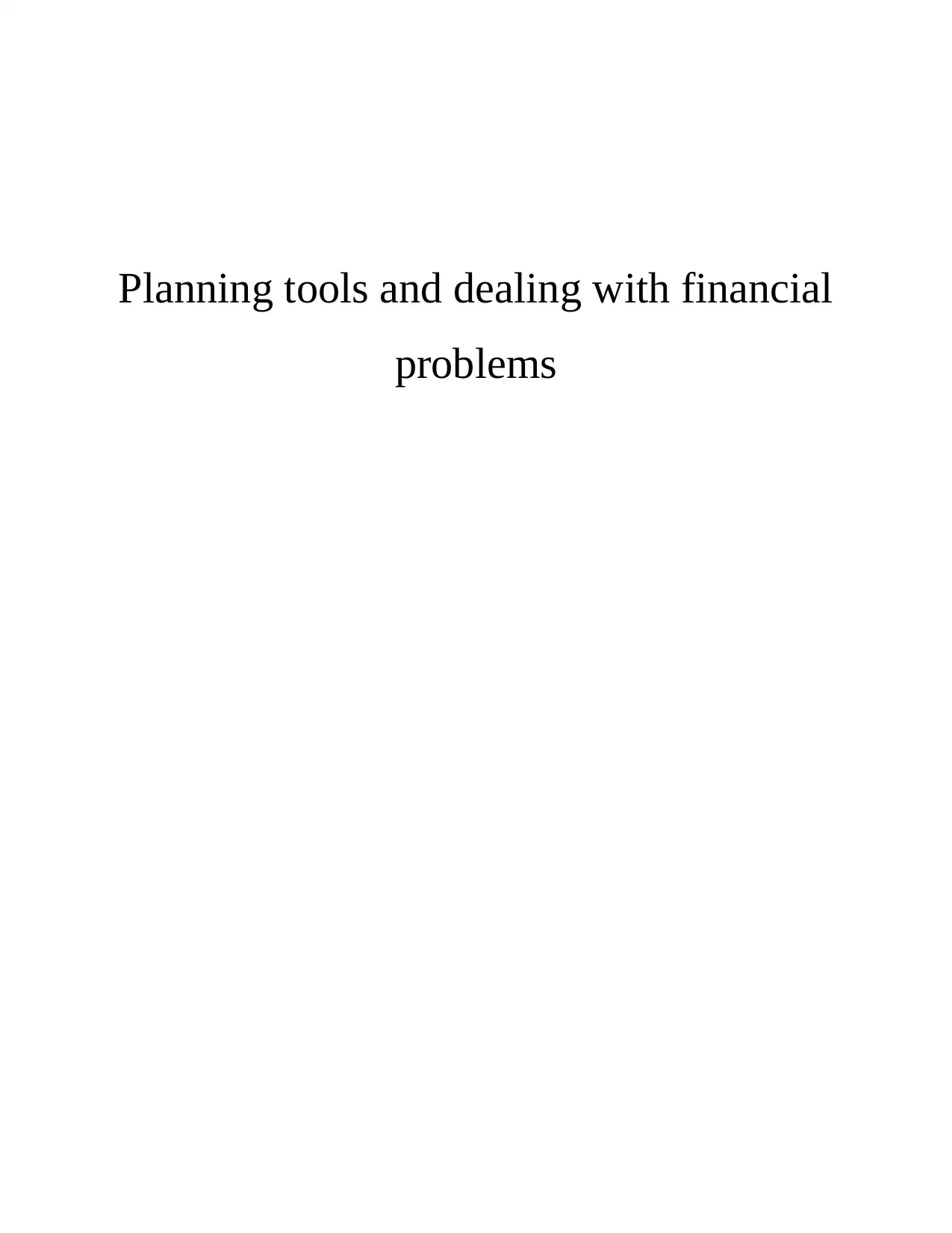
Planning tools and dealing with financial
problems
problems
Paraphrase This Document
Need a fresh take? Get an instant paraphrase of this document with our AI Paraphraser
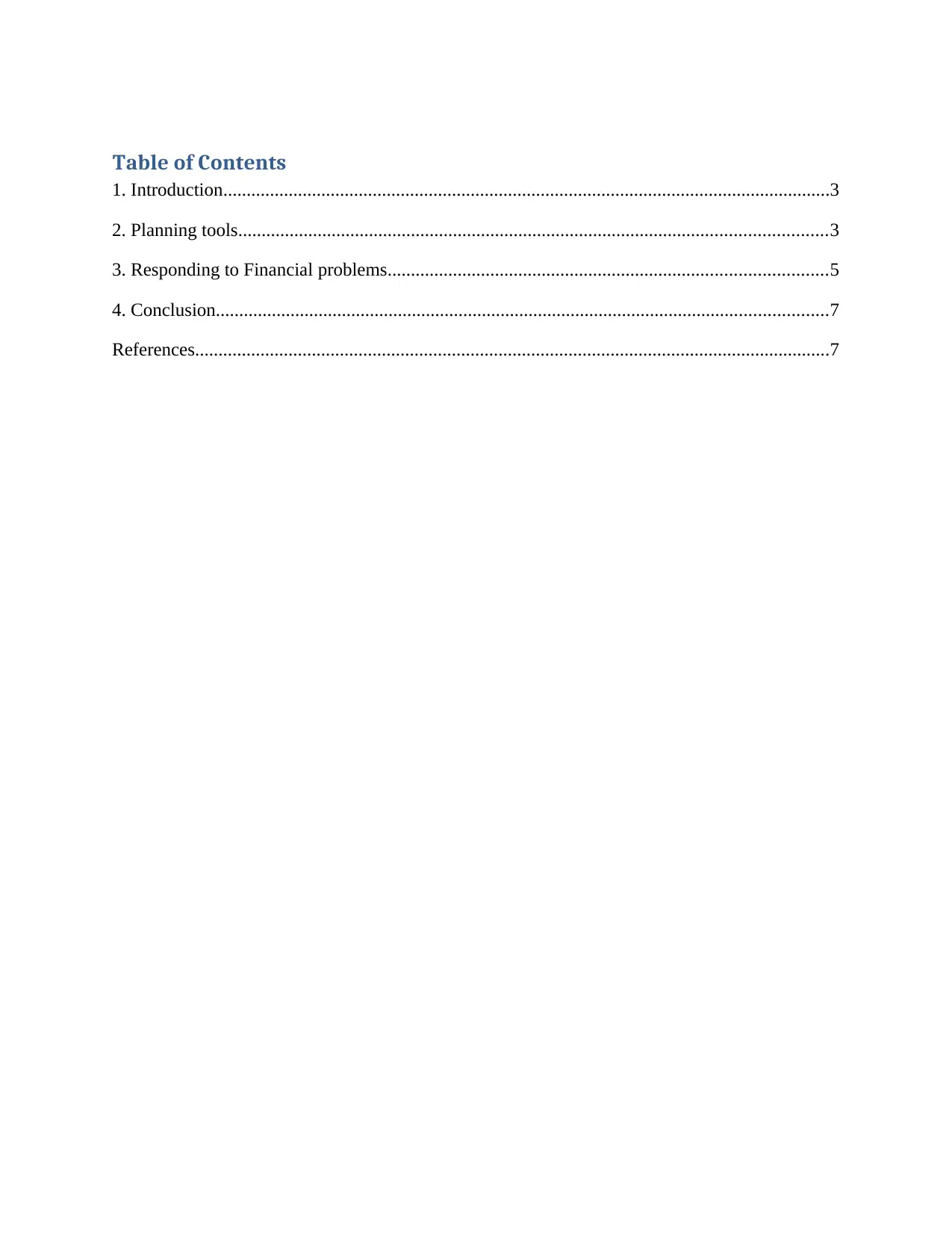
Table of Contents
1. Introduction..................................................................................................................................3
2. Planning tools..............................................................................................................................3
3. Responding to Financial problems..............................................................................................5
4. Conclusion...................................................................................................................................7
References........................................................................................................................................7
1. Introduction..................................................................................................................................3
2. Planning tools..............................................................................................................................3
3. Responding to Financial problems..............................................................................................5
4. Conclusion...................................................................................................................................7
References........................................................................................................................................7
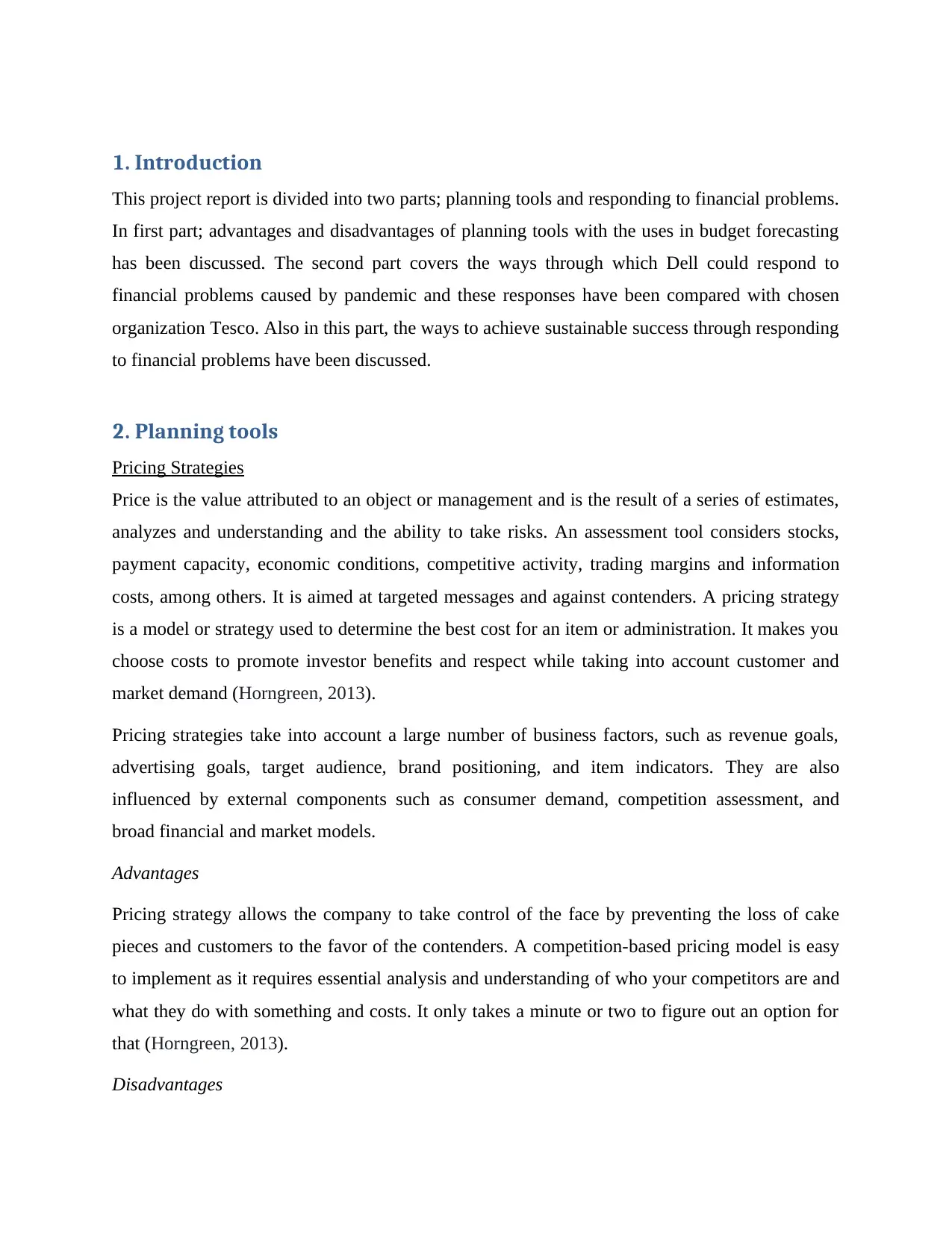
1. Introduction
This project report is divided into two parts; planning tools and responding to financial problems.
In first part; advantages and disadvantages of planning tools with the uses in budget forecasting
has been discussed. The second part covers the ways through which Dell could respond to
financial problems caused by pandemic and these responses have been compared with chosen
organization Tesco. Also in this part, the ways to achieve sustainable success through responding
to financial problems have been discussed.
2. Planning tools
Pricing Strategies
Price is the value attributed to an object or management and is the result of a series of estimates,
analyzes and understanding and the ability to take risks. An assessment tool considers stocks,
payment capacity, economic conditions, competitive activity, trading margins and information
costs, among others. It is aimed at targeted messages and against contenders. A pricing strategy
is a model or strategy used to determine the best cost for an item or administration. It makes you
choose costs to promote investor benefits and respect while taking into account customer and
market demand (Horngreen, 2013).
Pricing strategies take into account a large number of business factors, such as revenue goals,
advertising goals, target audience, brand positioning, and item indicators. They are also
influenced by external components such as consumer demand, competition assessment, and
broad financial and market models.
Advantages
Pricing strategy allows the company to take control of the face by preventing the loss of cake
pieces and customers to the favor of the contenders. A competition-based pricing model is easy
to implement as it requires essential analysis and understanding of who your competitors are and
what they do with something and costs. It only takes a minute or two to figure out an option for
that (Horngreen, 2013).
Disadvantages
This project report is divided into two parts; planning tools and responding to financial problems.
In first part; advantages and disadvantages of planning tools with the uses in budget forecasting
has been discussed. The second part covers the ways through which Dell could respond to
financial problems caused by pandemic and these responses have been compared with chosen
organization Tesco. Also in this part, the ways to achieve sustainable success through responding
to financial problems have been discussed.
2. Planning tools
Pricing Strategies
Price is the value attributed to an object or management and is the result of a series of estimates,
analyzes and understanding and the ability to take risks. An assessment tool considers stocks,
payment capacity, economic conditions, competitive activity, trading margins and information
costs, among others. It is aimed at targeted messages and against contenders. A pricing strategy
is a model or strategy used to determine the best cost for an item or administration. It makes you
choose costs to promote investor benefits and respect while taking into account customer and
market demand (Horngreen, 2013).
Pricing strategies take into account a large number of business factors, such as revenue goals,
advertising goals, target audience, brand positioning, and item indicators. They are also
influenced by external components such as consumer demand, competition assessment, and
broad financial and market models.
Advantages
Pricing strategy allows the company to take control of the face by preventing the loss of cake
pieces and customers to the favor of the contenders. A competition-based pricing model is easy
to implement as it requires essential analysis and understanding of who your competitors are and
what they do with something and costs. It only takes a minute or two to figure out an option for
that (Horngreen, 2013).
Disadvantages
⊘ This is a preview!⊘
Do you want full access?
Subscribe today to unlock all pages.

Trusted by 1+ million students worldwide
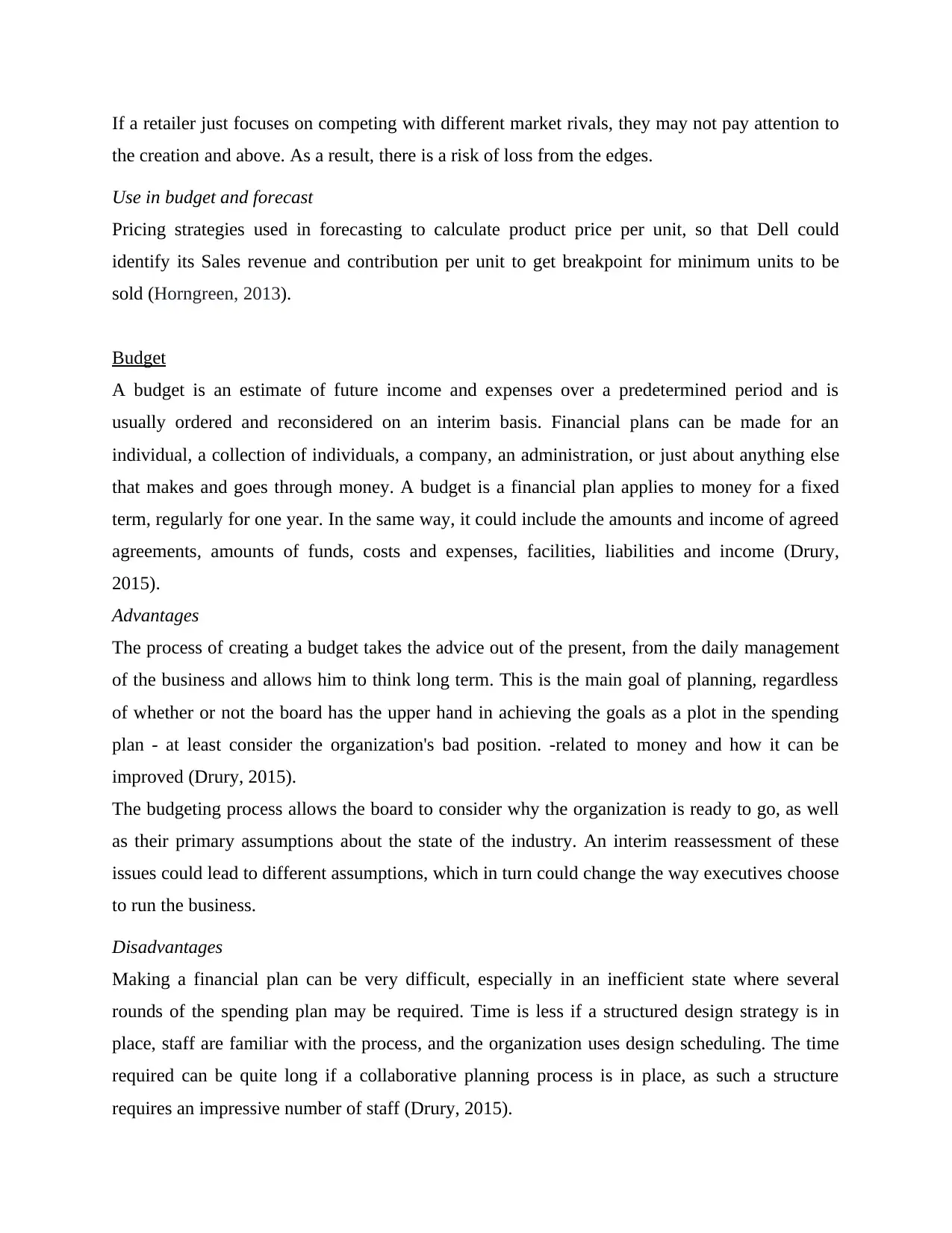
If a retailer just focuses on competing with different market rivals, they may not pay attention to
the creation and above. As a result, there is a risk of loss from the edges.
Use in budget and forecast
Pricing strategies used in forecasting to calculate product price per unit, so that Dell could
identify its Sales revenue and contribution per unit to get breakpoint for minimum units to be
sold (Horngreen, 2013).
Budget
A budget is an estimate of future income and expenses over a predetermined period and is
usually ordered and reconsidered on an interim basis. Financial plans can be made for an
individual, a collection of individuals, a company, an administration, or just about anything else
that makes and goes through money. A budget is a financial plan applies to money for a fixed
term, regularly for one year. In the same way, it could include the amounts and income of agreed
agreements, amounts of funds, costs and expenses, facilities, liabilities and income (Drury,
2015).
Advantages
The process of creating a budget takes the advice out of the present, from the daily management
of the business and allows him to think long term. This is the main goal of planning, regardless
of whether or not the board has the upper hand in achieving the goals as a plot in the spending
plan - at least consider the organization's bad position. -related to money and how it can be
improved (Drury, 2015).
The budgeting process allows the board to consider why the organization is ready to go, as well
as their primary assumptions about the state of the industry. An interim reassessment of these
issues could lead to different assumptions, which in turn could change the way executives choose
to run the business.
Disadvantages
Making a financial plan can be very difficult, especially in an inefficient state where several
rounds of the spending plan may be required. Time is less if a structured design strategy is in
place, staff are familiar with the process, and the organization uses design scheduling. The time
required can be quite long if a collaborative planning process is in place, as such a structure
requires an impressive number of staff (Drury, 2015).
the creation and above. As a result, there is a risk of loss from the edges.
Use in budget and forecast
Pricing strategies used in forecasting to calculate product price per unit, so that Dell could
identify its Sales revenue and contribution per unit to get breakpoint for minimum units to be
sold (Horngreen, 2013).
Budget
A budget is an estimate of future income and expenses over a predetermined period and is
usually ordered and reconsidered on an interim basis. Financial plans can be made for an
individual, a collection of individuals, a company, an administration, or just about anything else
that makes and goes through money. A budget is a financial plan applies to money for a fixed
term, regularly for one year. In the same way, it could include the amounts and income of agreed
agreements, amounts of funds, costs and expenses, facilities, liabilities and income (Drury,
2015).
Advantages
The process of creating a budget takes the advice out of the present, from the daily management
of the business and allows him to think long term. This is the main goal of planning, regardless
of whether or not the board has the upper hand in achieving the goals as a plot in the spending
plan - at least consider the organization's bad position. -related to money and how it can be
improved (Drury, 2015).
The budgeting process allows the board to consider why the organization is ready to go, as well
as their primary assumptions about the state of the industry. An interim reassessment of these
issues could lead to different assumptions, which in turn could change the way executives choose
to run the business.
Disadvantages
Making a financial plan can be very difficult, especially in an inefficient state where several
rounds of the spending plan may be required. Time is less if a structured design strategy is in
place, staff are familiar with the process, and the organization uses design scheduling. The time
required can be quite long if a collaborative planning process is in place, as such a structure
requires an impressive number of staff (Drury, 2015).
Paraphrase This Document
Need a fresh take? Get an instant paraphrase of this document with our AI Paraphraser
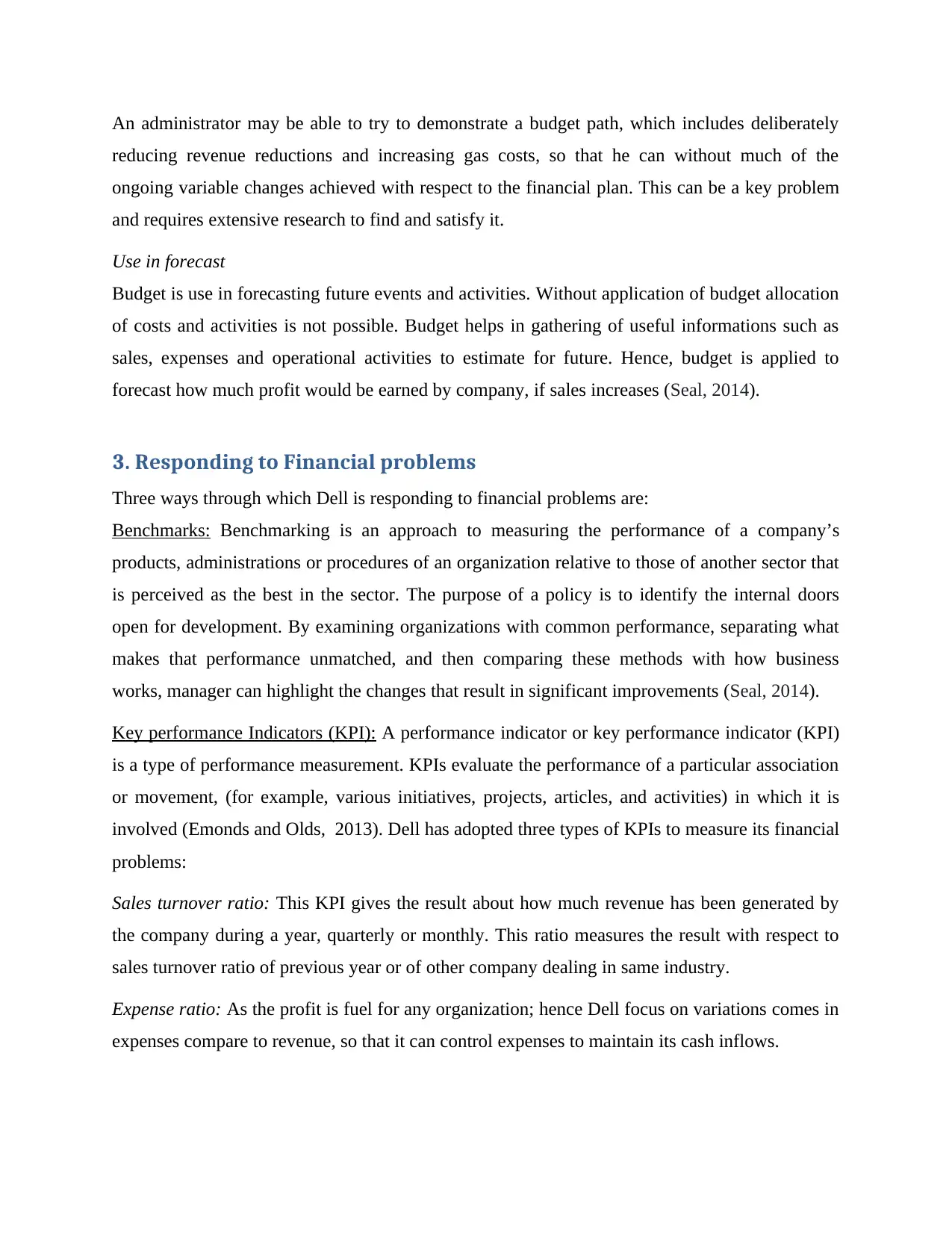
An administrator may be able to try to demonstrate a budget path, which includes deliberately
reducing revenue reductions and increasing gas costs, so that he can without much of the
ongoing variable changes achieved with respect to the financial plan. This can be a key problem
and requires extensive research to find and satisfy it.
Use in forecast
Budget is use in forecasting future events and activities. Without application of budget allocation
of costs and activities is not possible. Budget helps in gathering of useful informations such as
sales, expenses and operational activities to estimate for future. Hence, budget is applied to
forecast how much profit would be earned by company, if sales increases (Seal, 2014).
3. Responding to Financial problems
Three ways through which Dell is responding to financial problems are:
Benchmarks: Benchmarking is an approach to measuring the performance of a company’s
products, administrations or procedures of an organization relative to those of another sector that
is perceived as the best in the sector. The purpose of a policy is to identify the internal doors
open for development. By examining organizations with common performance, separating what
makes that performance unmatched, and then comparing these methods with how business
works, manager can highlight the changes that result in significant improvements (Seal, 2014).
Key performance Indicators (KPI): A performance indicator or key performance indicator (KPI)
is a type of performance measurement. KPIs evaluate the performance of a particular association
or movement, (for example, various initiatives, projects, articles, and activities) in which it is
involved (Emonds and Olds, 2013). Dell has adopted three types of KPIs to measure its financial
problems:
Sales turnover ratio: This KPI gives the result about how much revenue has been generated by
the company during a year, quarterly or monthly. This ratio measures the result with respect to
sales turnover ratio of previous year or of other company dealing in same industry.
Expense ratio: As the profit is fuel for any organization; hence Dell focus on variations comes in
expenses compare to revenue, so that it can control expenses to maintain its cash inflows.
reducing revenue reductions and increasing gas costs, so that he can without much of the
ongoing variable changes achieved with respect to the financial plan. This can be a key problem
and requires extensive research to find and satisfy it.
Use in forecast
Budget is use in forecasting future events and activities. Without application of budget allocation
of costs and activities is not possible. Budget helps in gathering of useful informations such as
sales, expenses and operational activities to estimate for future. Hence, budget is applied to
forecast how much profit would be earned by company, if sales increases (Seal, 2014).
3. Responding to Financial problems
Three ways through which Dell is responding to financial problems are:
Benchmarks: Benchmarking is an approach to measuring the performance of a company’s
products, administrations or procedures of an organization relative to those of another sector that
is perceived as the best in the sector. The purpose of a policy is to identify the internal doors
open for development. By examining organizations with common performance, separating what
makes that performance unmatched, and then comparing these methods with how business
works, manager can highlight the changes that result in significant improvements (Seal, 2014).
Key performance Indicators (KPI): A performance indicator or key performance indicator (KPI)
is a type of performance measurement. KPIs evaluate the performance of a particular association
or movement, (for example, various initiatives, projects, articles, and activities) in which it is
involved (Emonds and Olds, 2013). Dell has adopted three types of KPIs to measure its financial
problems:
Sales turnover ratio: This KPI gives the result about how much revenue has been generated by
the company during a year, quarterly or monthly. This ratio measures the result with respect to
sales turnover ratio of previous year or of other company dealing in same industry.
Expense ratio: As the profit is fuel for any organization; hence Dell focus on variations comes in
expenses compare to revenue, so that it can control expenses to maintain its cash inflows.
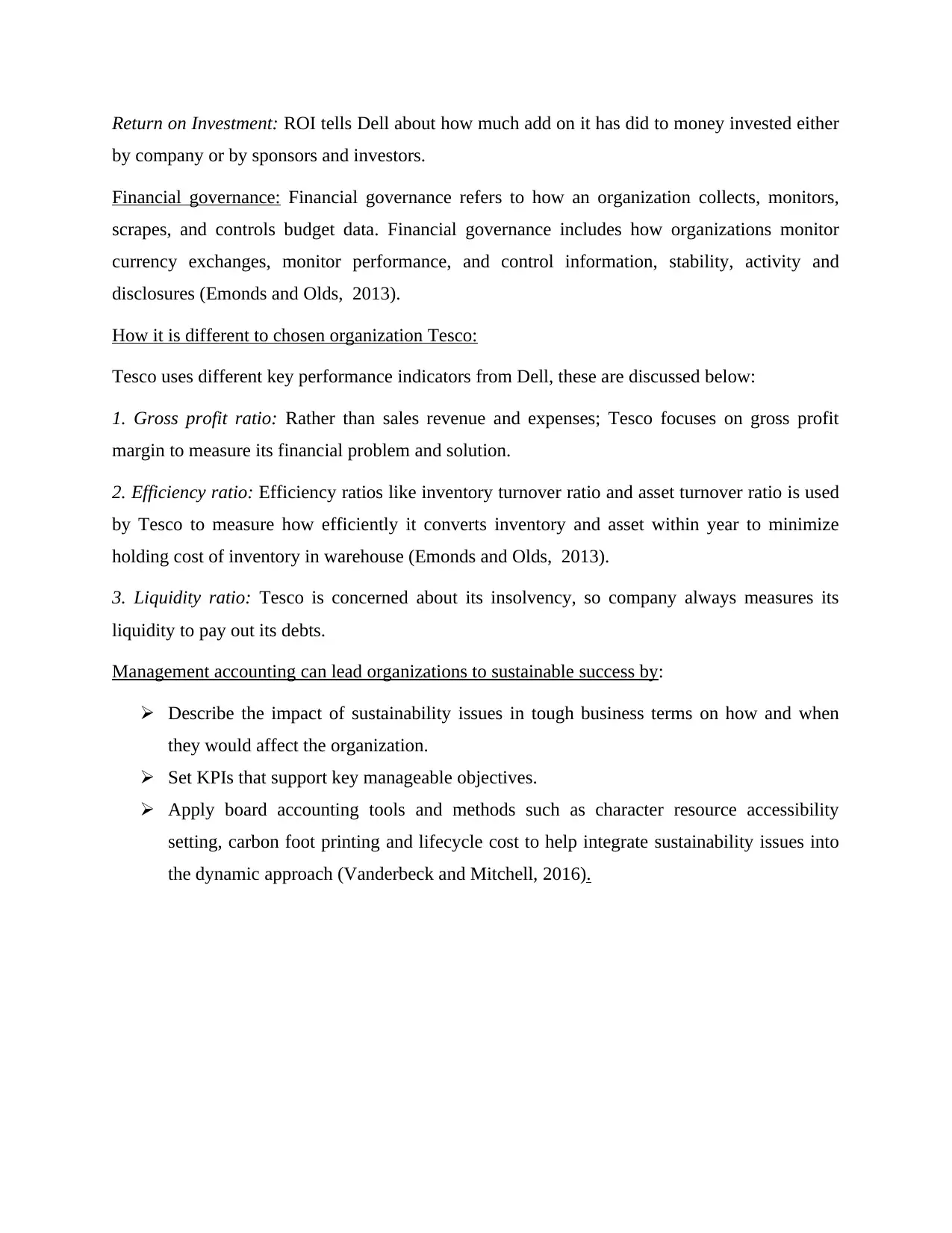
Return on Investment: ROI tells Dell about how much add on it has did to money invested either
by company or by sponsors and investors.
Financial governance: Financial governance refers to how an organization collects, monitors,
scrapes, and controls budget data. Financial governance includes how organizations monitor
currency exchanges, monitor performance, and control information, stability, activity and
disclosures (Emonds and Olds, 2013).
How it is different to chosen organization Tesco:
Tesco uses different key performance indicators from Dell, these are discussed below:
1. Gross profit ratio: Rather than sales revenue and expenses; Tesco focuses on gross profit
margin to measure its financial problem and solution.
2. Efficiency ratio: Efficiency ratios like inventory turnover ratio and asset turnover ratio is used
by Tesco to measure how efficiently it converts inventory and asset within year to minimize
holding cost of inventory in warehouse (Emonds and Olds, 2013).
3. Liquidity ratio: Tesco is concerned about its insolvency, so company always measures its
liquidity to pay out its debts.
Management accounting can lead organizations to sustainable success by:
Describe the impact of sustainability issues in tough business terms on how and when
they would affect the organization.
Set KPIs that support key manageable objectives.
Apply board accounting tools and methods such as character resource accessibility
setting, carbon foot printing and lifecycle cost to help integrate sustainability issues into
the dynamic approach (Vanderbeck and Mitchell, 2016).
by company or by sponsors and investors.
Financial governance: Financial governance refers to how an organization collects, monitors,
scrapes, and controls budget data. Financial governance includes how organizations monitor
currency exchanges, monitor performance, and control information, stability, activity and
disclosures (Emonds and Olds, 2013).
How it is different to chosen organization Tesco:
Tesco uses different key performance indicators from Dell, these are discussed below:
1. Gross profit ratio: Rather than sales revenue and expenses; Tesco focuses on gross profit
margin to measure its financial problem and solution.
2. Efficiency ratio: Efficiency ratios like inventory turnover ratio and asset turnover ratio is used
by Tesco to measure how efficiently it converts inventory and asset within year to minimize
holding cost of inventory in warehouse (Emonds and Olds, 2013).
3. Liquidity ratio: Tesco is concerned about its insolvency, so company always measures its
liquidity to pay out its debts.
Management accounting can lead organizations to sustainable success by:
Describe the impact of sustainability issues in tough business terms on how and when
they would affect the organization.
Set KPIs that support key manageable objectives.
Apply board accounting tools and methods such as character resource accessibility
setting, carbon foot printing and lifecycle cost to help integrate sustainability issues into
the dynamic approach (Vanderbeck and Mitchell, 2016).
⊘ This is a preview!⊘
Do you want full access?
Subscribe today to unlock all pages.

Trusted by 1+ million students worldwide
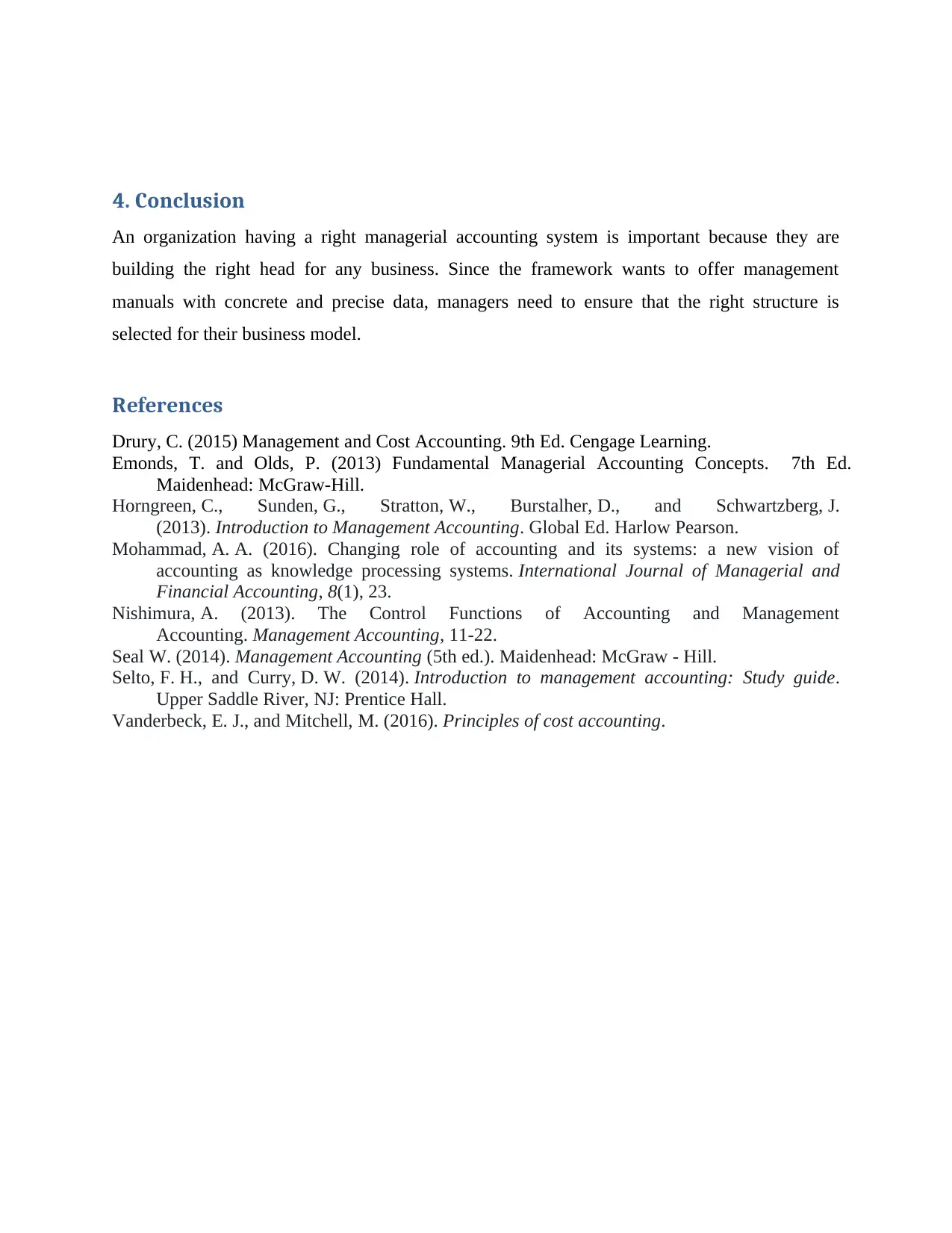
4. Conclusion
An organization having a right managerial accounting system is important because they are
building the right head for any business. Since the framework wants to offer management
manuals with concrete and precise data, managers need to ensure that the right structure is
selected for their business model.
References
Drury, C. (2015) Management and Cost Accounting. 9th Ed. Cengage Learning.
Emonds, T. and Olds, P. (2013) Fundamental Managerial Accounting Concepts. 7th Ed.
Maidenhead: McGraw-Hill.
Horngreen, C., Sunden, G., Stratton, W., Burstalher, D., and Schwartzberg, J.
(2013). Introduction to Management Accounting. Global Ed. Harlow Pearson.
Mohammad, A. A. (2016). Changing role of accounting and its systems: a new vision of
accounting as knowledge processing systems. International Journal of Managerial and
Financial Accounting, 8(1), 23.
Nishimura, A. (2013). The Control Functions of Accounting and Management
Accounting. Management Accounting, 11-22.
Seal W. (2014). Management Accounting (5th ed.). Maidenhead: McGraw - Hill.
Selto, F. H., and Curry, D. W. (2014). Introduction to management accounting: Study guide.
Upper Saddle River, NJ: Prentice Hall.
Vanderbeck, E. J., and Mitchell, M. (2016). Principles of cost accounting.
An organization having a right managerial accounting system is important because they are
building the right head for any business. Since the framework wants to offer management
manuals with concrete and precise data, managers need to ensure that the right structure is
selected for their business model.
References
Drury, C. (2015) Management and Cost Accounting. 9th Ed. Cengage Learning.
Emonds, T. and Olds, P. (2013) Fundamental Managerial Accounting Concepts. 7th Ed.
Maidenhead: McGraw-Hill.
Horngreen, C., Sunden, G., Stratton, W., Burstalher, D., and Schwartzberg, J.
(2013). Introduction to Management Accounting. Global Ed. Harlow Pearson.
Mohammad, A. A. (2016). Changing role of accounting and its systems: a new vision of
accounting as knowledge processing systems. International Journal of Managerial and
Financial Accounting, 8(1), 23.
Nishimura, A. (2013). The Control Functions of Accounting and Management
Accounting. Management Accounting, 11-22.
Seal W. (2014). Management Accounting (5th ed.). Maidenhead: McGraw - Hill.
Selto, F. H., and Curry, D. W. (2014). Introduction to management accounting: Study guide.
Upper Saddle River, NJ: Prentice Hall.
Vanderbeck, E. J., and Mitchell, M. (2016). Principles of cost accounting.
1 out of 7
Related Documents
Your All-in-One AI-Powered Toolkit for Academic Success.
+13062052269
info@desklib.com
Available 24*7 on WhatsApp / Email
![[object Object]](/_next/static/media/star-bottom.7253800d.svg)
Unlock your academic potential
Copyright © 2020–2025 A2Z Services. All Rights Reserved. Developed and managed by ZUCOL.





